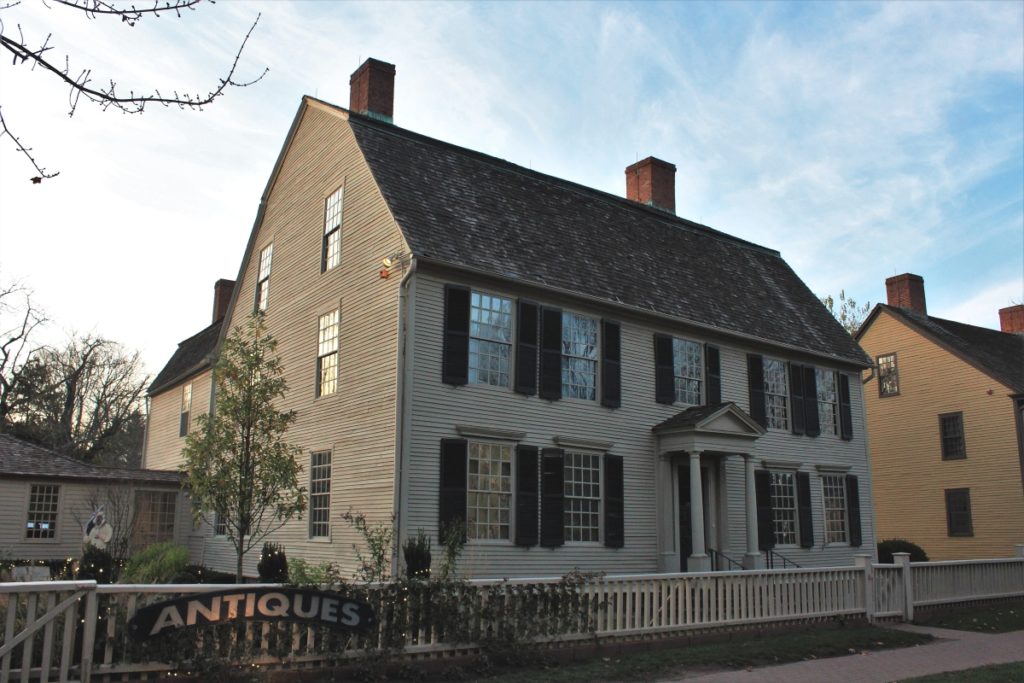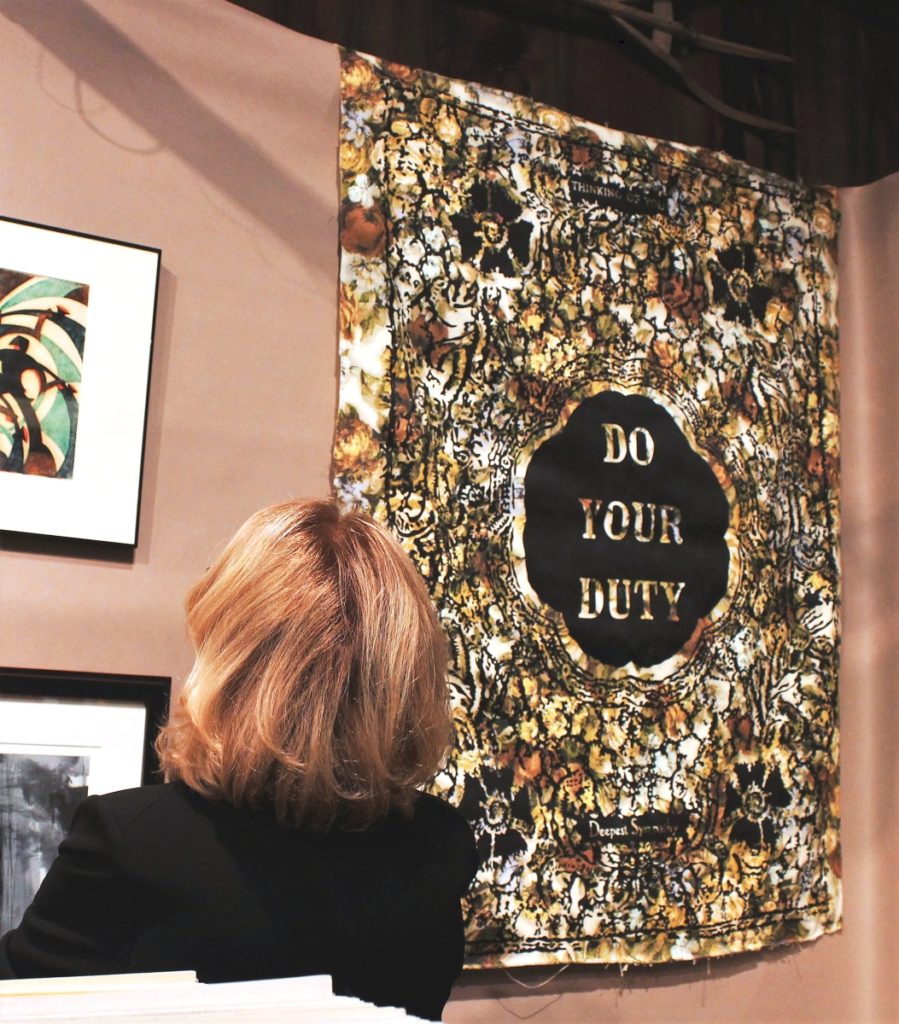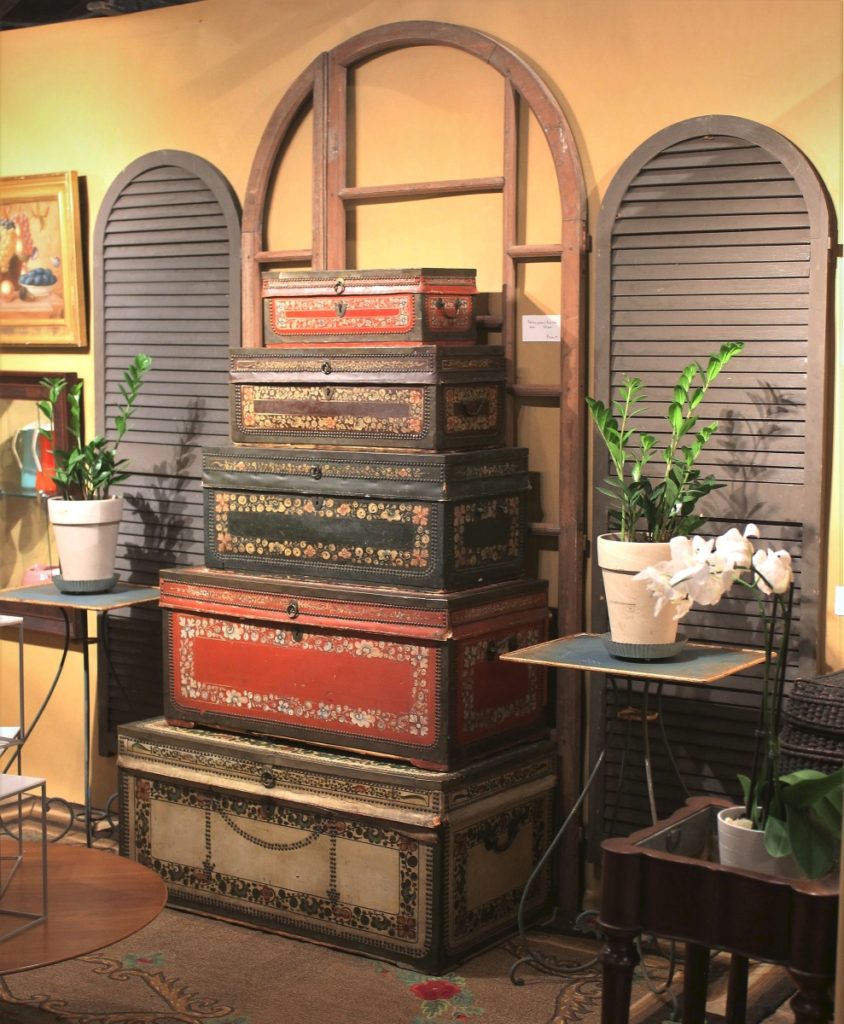
The Joseph Webb House, built in 1752, served as George Washington’s headquarters in 1781 and hosted the planning that led to the victory at Yorktown.
Review & Photos by Z.G. Burnett
WETHERSFIELD, CONN. – The Wethersfield Antiques Show took place during the weekend of November 5 and 6, with an evening preview party on Friday, November 4. The historic surroundings of the Webb-Deane-Stevens Museum (WDS) lent themselves in spades to the artfully arranged antiques in each of the 22 vendors’ booths. The Wethersfield Antiques Show was revived last year after being retired in 2017, and it was the second anniversary of WDS hosting the show; the preview progressed with elegance and apparent ease typically achieved even by much longer-running shows. “The show was well received among guests and dealers,” said Joshua Campbell Torrance, executive director of WDS, “The show is garnering positive word of mouth and is growing.”
The vendor spaces were installed at two locations on the WDS property: the Holcombe Education Center and the Webb Barn. The education center is attached to the Webb House, a National Historic Landmark built by Joseph Webb in 1752. Joseph Webb II and his wife Abigail Chester inherited the property and were known for their lavish entertainments, earning the house the nickname “Hospitality Hall.” This graciousness helped the war effort in 1781, when General George Washington used the Webb house as his headquarters. It was here that he and Jean-Baptiste Donatien de Vimeur, comte de Rochambeau, planned the joint military campaign that led to the victory at Yorktown. To commemorate this history, author and reenactor John Koopman III also attended the preview, portraying the general. Wallace Nutting bought and renovated the house in 1916, selling it to the Colonial Dames of Connecticut three years later to be preserved as a house museum.
The Webb Barn is a replacement for the site’s original structure, which was allegedly burnt down in 1840. Built by then-owner Martin Wells that same year, the current barn was renovated and moved back 30 feet in 1921 with funds raised by the Colonial Dames. Since the 1930s, it has been expanded using materials salvaged from other Nineteenth Century barns and is now a comfortable reception space that can accommodate up to 135 people. Eight vendors were set up in the barn with room to spare for customers, caterers and live musicians.

This wall hanging was slate-printed on heavy printed cotton fabric by William Kent (American, 1919-2012) and offered by Marc Chabot Fine Art for $2,800.
Despite the education center’s modern accommodations, every vendor used inventory to transform their spaces into period rooms. The appropriately named New England Home Antiques, owned and operated by Wethersfield local Bruce Henley, made a tavern out of his booth, complete with antique glass and barware. “It’s not as popular as it used to be,” Henley said of the medium, “but I always bring some [early glass] because each piece is unique.” Another rare object Henley offered was the document box of Captain John E. Barstow (Hanover, Mass., 1822-1904). According to records in the Mystic Seaport Museum, Barstow was shipmaster and then captain of at least four vessels out of New York during his career. The museum’s G.W. Blunt Library also contains a collection of Barstow’s reminiscences, written by his hand as well as transcribed, and sketches, including watercolors. The document box was similarly decorated with cutouts and stencil drawings; however, it is unclear if these were later additions.
Randi Ona created a welcoming dining area in her booth, shared by Hollis E. Brodrick. Prominently displayed was a folk portrait of a fashionable young woman attributed to William Kennedy (American, 1817-1871). “The lighter shaded background and trees are unusual features of Prior school portraits,” Ona noted. From the collection of Mary Allis (Southport, Conn.), the portrait also had provenance to the collection of Mr and Mrs Jerome Blum. It was in excellent condition with what appeared to be its original frame and glass. Brodrick offered what may have been the best piece of early glass at the show, an early English export sealed wine bottle with the initials “R.L.” and dated 1741. Sealed bottles of this kind are highly sought-after as they can often be linked to their original companies. Brodrick was asking $4,500.
Vendors were discerning in their selections for the show, especially when it came to Connecticut furniture. Daniel and Karen Olsen brought a striking Queen Anne highboy from the area that was once in the Peter Tillou collection, which was distinctive for its double fan carvings on the upper case and the supporting bottom. “It would have been in the area of $15,000 a few years ago,” Olson lamented. “We’re offering it for $4,600.” In the barn, Martin J. Ferrick also featured a Connecticut cherry Chippendale lowboy with a rare pinwheel carving, asking $1,895. If not of a definite regional attribution, many pieces had Connecticut provenance, including an early rocking chair from Colette Donovan. Known as a “make-do” chair, Donovan originally sold the rocker to a couple who owned the two earliest homes in Guilford, Conn., who later resold to her. Aside from being reupholstered with linsey-woolsey fabric, the chair has been largely unrestored and was built to last.
Decorative arts were prolific. The largest hooked rug in the show belonged to Laura McCarthy of Bayberry Antiques, measuring 32¾ by 61 inches and showing two cats on a branch surrounded by leaves and acorns. “In 39 years of dealing, I’ve only ever seen this pattern in a book by Stella Hay Rex,” McCarthy shared, adding that the pattern is titled “Pennsylvania Cats.” Adding to the rug’s rarity, its tan background was made of camel’s wool instead of the more common sheep wool. McCarthy restored the backing with wool herself and was asking the reasonable price of $975.

John Hunt Marshall of Westhampton, Mass., was selling this stacking group of Nineteenth Century China trade boxes for $10,500; each was hand painted and of similar make, but most likely not by the same hand.
An abundance of decoys contributed to the show’s homey atmosphere, with a large flock of carved and painted birds alighting on the otherwise Christmas-themed Mad River Antiques booth. All but one of these was painted by James Lapham of Dennisport, Mass., which were half-sized or quarter-sized models of game birds and a sparrow hawk. The other bird, a miniature Mallard drake, was made by the Crowells of East Harwich, Mass., who were an apparent influence on Lapham’s work. The base was impressed with the A.E. Crowell mark, used both by A. Elmer Crowell (1862-1952) and his son, Cleon (active 1928-1962). Two of Crowell’s birds, a pintail drake and a Canada goose, sold in 2007 for $1.13 million.
It was not all brown furniture and folk art in the barn at Westchester. Marc Chabot Fine Arts also occupied a corner booth among the barn’s Americana dealers, displaying a large collection of work by William “Bill” Kent. A World War II veteran who studied at Yale, Kent’s work is imbued with his strong sense of morality, justice and civic responsibility. Originally a musician and sculptor, Kent discovered slate carving during his time at Yale and began using the material to make large and small-scale prints. Many of these are inspired by American gravestone carvings, and their motifs often appear in his work alongside his own contemporary symbols. One of the large hangings in Chabot’s booth was a print on cotton tapestry titled “Do Your Duty,” one of 46 in a series. The earthy tones of the floral fabric beneath Kent’s intricate patterning create an almost camouflaged effect, inspired by Victorian greeting cards and die casts. The phrases on the tapestry, “Thinking of You” and “Deepest Sympathy” contrast with the command “Do Your Duty,” commenting on the conflicted state of the nation while in the midst of the Vietnam War (1955-75). Chabot works with the Kent estate to sell the work of the late artist, of whom he is a great admirer, and was asking $2,800 for the tapestry.
The Webb-Deane-Stevens Museum is at 211 Main Street and will host a Candlelight Open House on December 8. For information, 860-529-0612 or www.webb-deane-stevens.org.




























